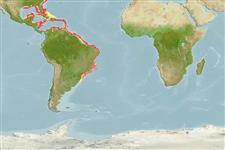Environment: milieu / climate zone / depth range / distribution range
Écologie
marin démersal; profondeur 60 - 300 m (Ref. 7251). Tropical; 35°N - 33°S, 100°W - 33°W
Western Atlantic: South Carolina, USA and northern Gulf of Mexico to the Caribbean Sea; probably more widespread. Reported from the northern coast of South America (Ref. 5217).
Taille / Poids / Âge
Maturity: Lm ? range ? - ? cm
Max length : 50.0 cm TL mâle / non sexé; (Ref. 5217); common length : 35.0 cm TL mâle / non sexé; (Ref. 5217)
Épines dorsales (Total) : 10; Rayons mous dorsaux (Total) : 14; Épines anales: 3; Rayons mous anaux: 8. Pelvic fin long, its tip extending posteriorly beyond origin of anal fin; caudal fin deeply emarginate, upper lobe projecting posteriorly; body silver with a pink cast dorsally, silvery-white ventrally; a yellow line extending from snout through lower edge of eye to posterior margin of opercle; pectoral fin pink, other fins yellow (Ref. 13608).
Occurs over hard bottoms.
Life cycle and mating behavior
Maturities | Reproduction | Spawnings | Egg(s) | Fecundities | Larves
Robins, C.R. and G.C. Ray, 1986. A field guide to Atlantic coast fishes of North America. Houghton Mifflin Company, Boston, U.S.A. 354 p. (Ref. 7251)
Statut dans la liste rouge de l'IUCN (Ref. 130435)
Menace pour l'homme
Harmless
Utilisations par l'homme
Pêcheries: commercial
Outils
Articles particuliers
Télécharger en XML
Sources Internet
Estimates based on models
Preferred temperature (Ref.
123201): 16.9 - 25.2, mean 20 °C (based on 103 cells).
Phylogenetic diversity index (Ref.
82804): PD
50 = 0.6250 [Uniqueness, from 0.5 = low to 2.0 = high].
Niveau trophique (Ref.
69278): 3.7 ±0.5 se; based on size and trophs of closest relatives
Résilience (Ref.
120179): Milieu, temps minimum de doublement de population : 1,4 à 4,4 années (Preliminary K or Fecundity.).
Fishing Vulnerability (Ref.
59153): Moderate vulnerability (40 of 100).
Nutrients (Ref.
124155): Calcium = 101 [42, 181] mg/100g; Iron = 0.896 [0.477, 1.637] mg/100g; Protein = 17.8 [16.0, 19.5] %; Omega3 = 0.28 [0.17, 0.48] g/100g; Selenium = 73 [40, 141] μg/100g; VitaminA = 23.8 [8.3, 78.2] μg/100g; Zinc = 0.956 [0.678, 1.400] mg/100g (wet weight);
